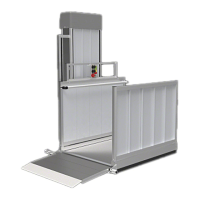Page | 22
23.3. GENERAL TROUBLESHOOTING
PROBLEM POTENTIAL CAUSE SOLUTION COMMENTS
Slow, erratic
operation, possible
“buzzing” or
“chattering” sounds
heard
Batteries have
discharged
See “Batteries Discharged”.
Main Power ON LED may be illuminated. The “buzzing” or “chattering”
sound is the reversing motor relay quickly making and breaking contact.
Slow, erratic
operation
Very cold
temperatures
Limit number of uses per day.
VPL performance falls off quickly at lower temperatures. This is inherent
to lead acid batteries. Their ability to supply power and accept a recharge
is diminished as temperature falls.
Slow, erratic
operation
Overuse Limit number of uses per day.
This VPL is intended for occasional use. If the unit is cycled too often the
charger cannot recharge the batteries between cycles. The motor can
also overheat. Several repeated cycles are possible if the VPL is allowed
to rest for 45 minutes to one hour between cycles. One full up/down cycle
requires approximately 10 to 15 minutes for the charger to bring the
batteries back to their pre-cycle charge level. Colder temperatures
increase the recharge time considerably.
Slow, erratic
operation
Lack of lubrication on
the Hi-Lead® Screw.
Clean and lubricate the Hi-Lead®
Screw.
Only EZ-ACCESS approved technicians may service the VPL. Consult
your dealer for service-related information.
Batteries
discharged
VPL has been
disconnected from
power source.
Plug VPL in, reset GFCI circuit.
Verify AC connections and
voltage in the junction box.
WARNING: The junction
box must be serviced by an
EZ-ACCESS approved
technician. Consult your
dealer for service-related
information.
Under normal temperatures and loads the VPL should operate
approximately 25 cycles before the batteries become discharged when
disconnected from the 120VAC power source required to operate the
battery charger. The indicator light in the charger will be red when the
batteries are charging and green once the batteries are fully charged.
NOTE: Lights on the charger can only be viewed with the power head
cover removed.
Batteries
discharged
Battery charger is not
working correctly
Green or red indicator on charger
will be illuminated if charger is
receiving 120VAC power. NOTE:
The lights on the charger can
only be viewed with the power
head cover removed.
The charger incorporates reverse polarity and overload protection. The
charger resets once condition is resolved. It may take 1-20 minutes
before the charger indicator light will come back on. Conditions other
than overload may require diagnosis and repair by an EZ-ACCESS
approved technician. Consult your dealer for service-related information.
Batteries
discharged
The battery charger
fuse has blown.
Check that the GFCI circuit has
not tripped.
GFCI protection devices sometimes control multiple receptacles. Ensure
GFCI components have been reset and are functioning properly.
Batteries
discharged
Battery charger is not
working correctly
Remove power head cover and
locate fuse #4 in the fuse block
(FIG 23.1). If the fuse is blown, it
must be replaced. See comment
to right.)
The circuit between the battery charger and the batteries is fused.
Under normal conditions this fuse should not blow. Look for problems in
the wires connected to the batteries before replacing the fuse.
Batteries
discharged
Batteries are defective
or near the end of
their service life
Load Test Batteries to gauge
performance level. NOTE: Only
EZ-ACCESS approved
technicians may service the VPL.
The service life of batteries under normal conditions is approximately
three years. One indication of a battery near the end of its service life is
that the VPL will operate one or two times normally, and then labor
during additional cycles. Cold weather will make this condition worse. A
newer defective battery will display similar symptoms although other
potential causes described previously should be explored before
considering battery replacement.

